
Discipline over dreaming. Action over analysis.
Everyone has ideas. Few have the discipline to see them through. Execution is where businesses are built—or broken. It’s not about being busy; it’s about doing what matters, doing it well, and doing it now.
Momentum beats motivation. Focus beats frenzy. And progress only comes when you stop planning and start moving—with intention. This chapter is a gut check for every leader who’s ever felt stuck in the swirl of strategy but hasn’t shipped the work.
If you’re serious about results, it’s time to do the hard things first—and learn by doing, not waiting.
Let’s put the ideas to the test.
Chapter 5, Execution Beats Ideas, features these 5 fundamental Rules:
- WEEK 19— Rule No.7: Momentum beats motivation.
- WEEK 20— Rule No. 8: Don’t mistake movement for progress.
- WEEK 21— Rule No. 9: Focus beats multitasking.
- WEEK 22— Rule No. 27: Do the hard things first.
- WEEK 23— Rule No. 28: Learn by doing.
WEEK 19
Rule No. 7: Momentum beats motivation.
Why: Because, you have to show up regardless of feelings.

Rule No. 7 SUMMARY ![]()
Don’t wait to feel inspired. Show up, act anyway, and let discipline build momentum. Waiting to feel inspired is a trap. Progress happens when you show up consistently—especially when you don’t feel like it. Motivation is fleeting; momentum is earned.
Ask Yourself: Where in my work am I waiting to feel motivated, when I could instead create momentum by taking consistent action?
WEEK 19 Action Step: Commit to one “non-negotiable” action every day this week, no matter how small, that moves a key business initiative forward. Record it, track it, and repeat—even if motivation is low. The goal is consistent motion, not perfect execution.
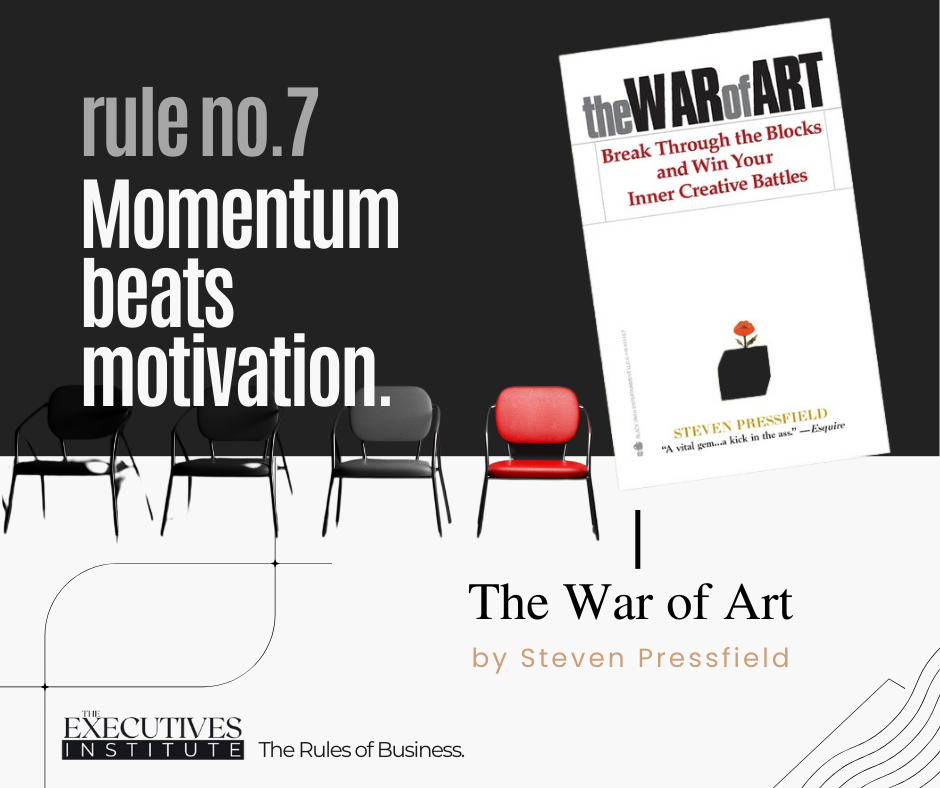
WEEK 19 RECOMMENDED READING: The War of Art by Steven Pressfield
“The amateur believes he must first overcome his fear; then he can do his work. The professional knows that fear can never be overcome. He knows there is no such thing as a fearless warrior or a dread-free artist.”
— Steven Pressfield, The War of Art
WEEK 20
Rule No. 8: Don’t mistake movement for progress.
Why: Because, activity ≠ results.
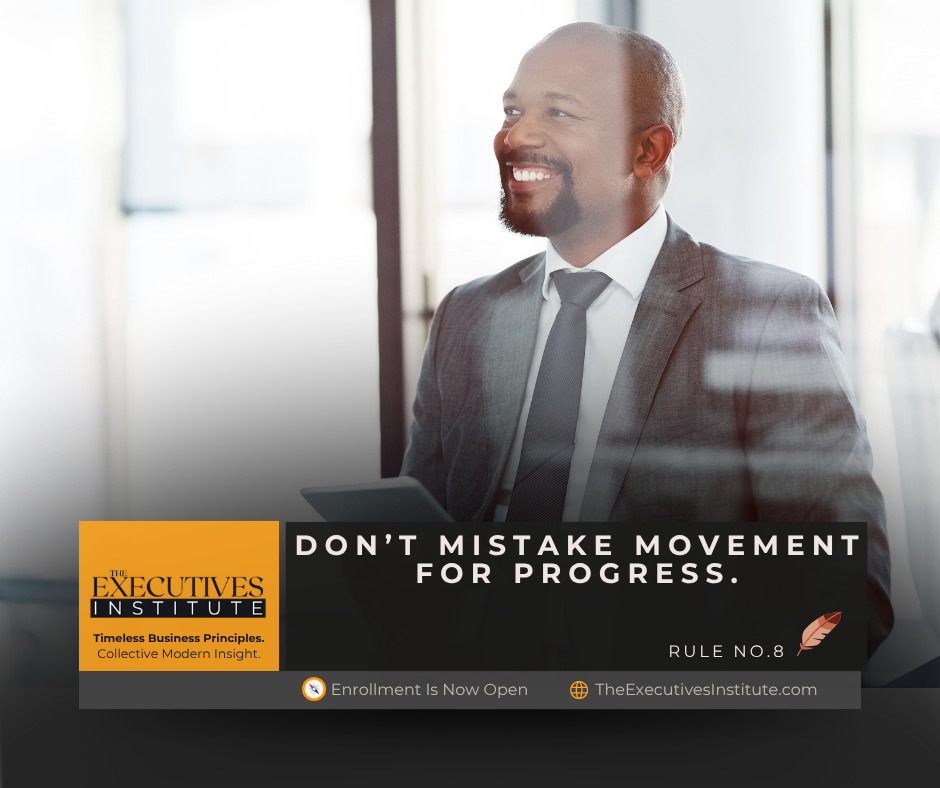
Rule No. 8 SUMMARY ![]()
It’s easy to confuse being busy with being effective. But motion without direction isn’t progress—it’s distraction in disguise. This rule reminds us that true advancement comes not from activity, but from purposeful, disciplined action.
Ask Yourself: Am I spending more time in motion than on meaningful outcomes? Which one change this week would create the biggest forward movement in my work or team?
WEEK 20 Action Step: Audit Your Activity: For one full day this week, track every task, meeting, and email. At the end of the day, categorize each item: essential, optional, or distracting. Identify at least one activity to eliminate or delegate, and commit to focusing on the tasks that truly drive progress.
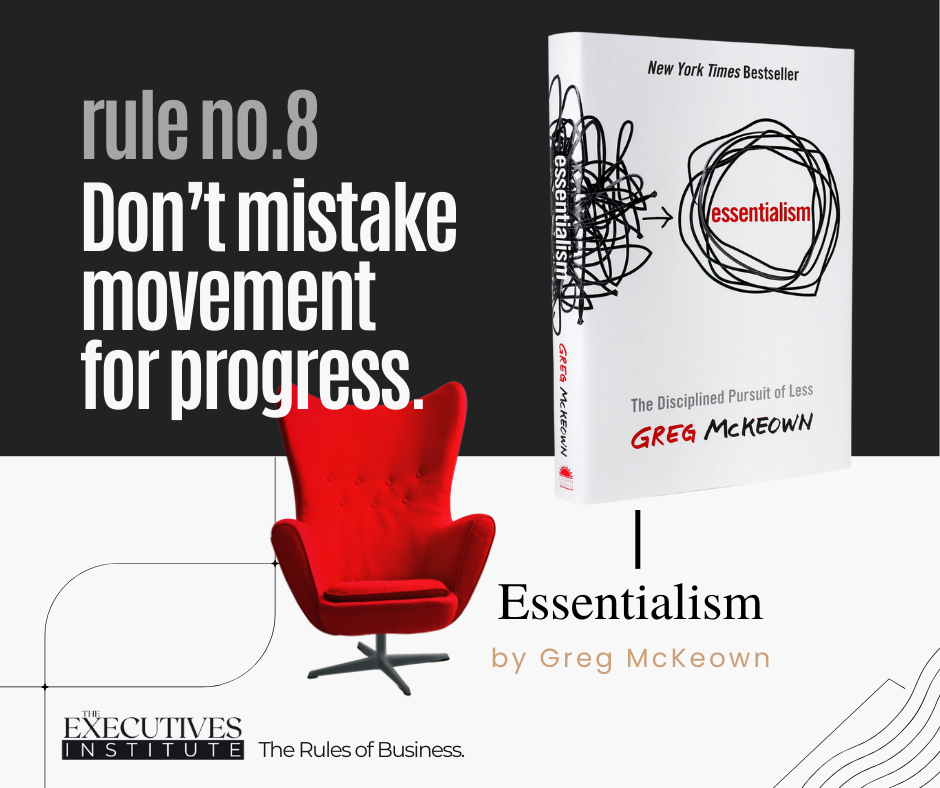
WEEK 20 RECOMMENDED READING: Essentialism by Greg McKeown
“What if we stopped celebrating being busy as a measure of importance? What if instead we celebrated how much time we had spent listening, pondering, meditating, and enjoying time with the most important people in our lives?”
— Greg McKeown, Essentialism
WEEK 21
Rule No. 9: Focus beats multitasking.
Why: Because, spreading thin kills momentum.

Rule No. 9 SUMMARY

Multitasking is a myth. Every time you split your attention, you dilute your effectiveness. This rule reminds us that meaningful progress doesn’t come from doing more things—it comes from doing the right thing with undivided attention.
Ask Yourself: Am I spending my time on the task that truly matters, or am I confusing activity with progress?
WEEK 21 Action Step: Identify your “One Thing” for the week.
- At the start of the week, list all key tasks and choose the single most important action that will drive the biggest results.
- Block uninterrupted time on your calendar to work exclusively on that task—no emails, calls, or side projects allowed during this window.
- Track progress daily, and review at week’s end: did focusing on one thing move the needle?
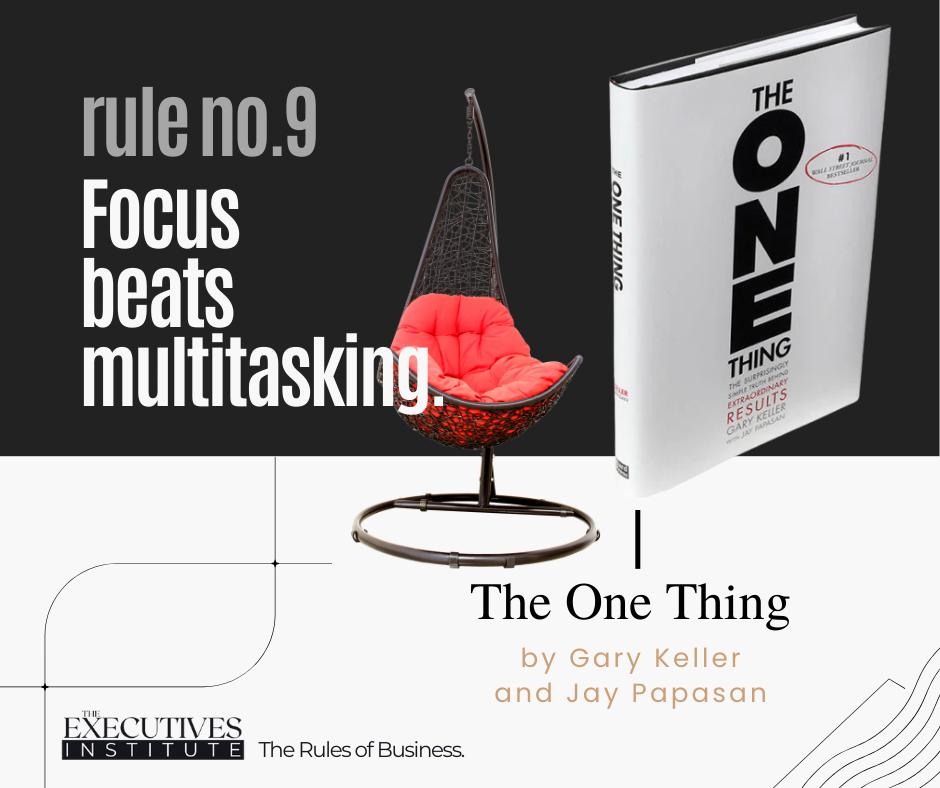
WEEK 21 RECOMMENDED READING: The One Thing by Gary Keller & Jay Papasan
“Multitasking is merely the opportunity to screw up more than one thing at a time.”
— Gary Keller, The One Thing
WEEK 22
Rule No. 27: Do the hard things first.
Why: Because discipline compounds.

Rule No. 27 SUMMARY ![]()
The tasks we avoid are often the ones that matter most. “Do the Hard Things First” is a call to discipline—tackle your toughest, highest-impact priorities before everything else. It’s not about doing more, it’s about doing what matters when your mind is sharp, your willpower is high, and your excuses haven’t shown up yet. In leadership and business, procrastination on the hard stuff is procrastination on progress.
Ask Yourself: Am I starting my day with tasks that matter most, or am I letting urgent but low-value work steal my energy?
WEEK 22 Action Step: Identify your “frog” for the week: List the top 1–3 high-impact tasks you’ve been avoiding. Schedule time first thing each day this week to tackle one of these tasks head-on—no distractions, no delays. Track your progress and note how your focus and momentum shift.
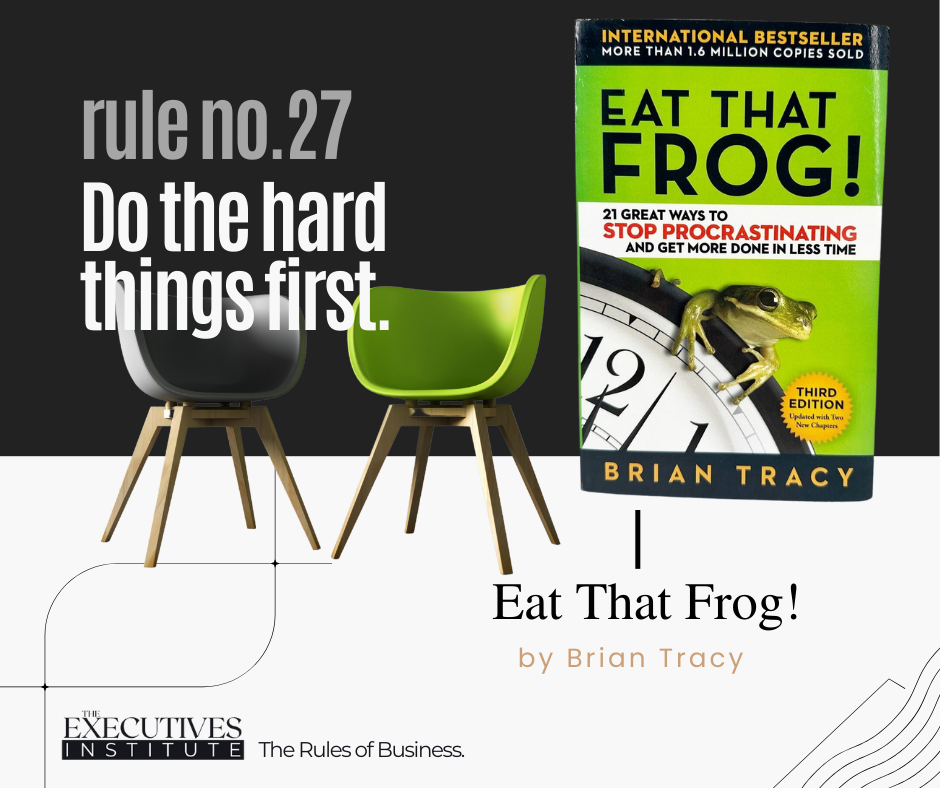
WEEK 22 RECOMMENDED READING: Eat That Frog by Brian Tracy
“One of the very worst uses of time is to do something very well that need not be done at all.”
— Brian Tracy, Eat That Frog!
WEEK 23
Rule No. 28: Learn by doing.
Why: Because, action beats endless planning.

Rule No. 28 SUMMARY ![]()
Real mastery doesn’t come from theory alone—it’s forged in action. Learn by Doing means getting your hands dirty, embracing failure as part of the process, and internalizing knowledge through lived experience. The most transformative growth comes when you stop preparing and start practicing under real conditions. This rule is a call to engage directly, iterate quickly, and let action teach you what thinking never could.
Ask Yourself: Where am I holding back from taking action because I’m afraid of imperfection, and what’s the smallest step I can take this week to turn learning into doing?
WEEK 23 Action Step: Take one meaningful action this week that moves a project, idea, or skill forward—without waiting for perfect conditions. Track what you learn from the outcome, including mistakes and unexpected insights. Document one key takeaway that can be applied next week.
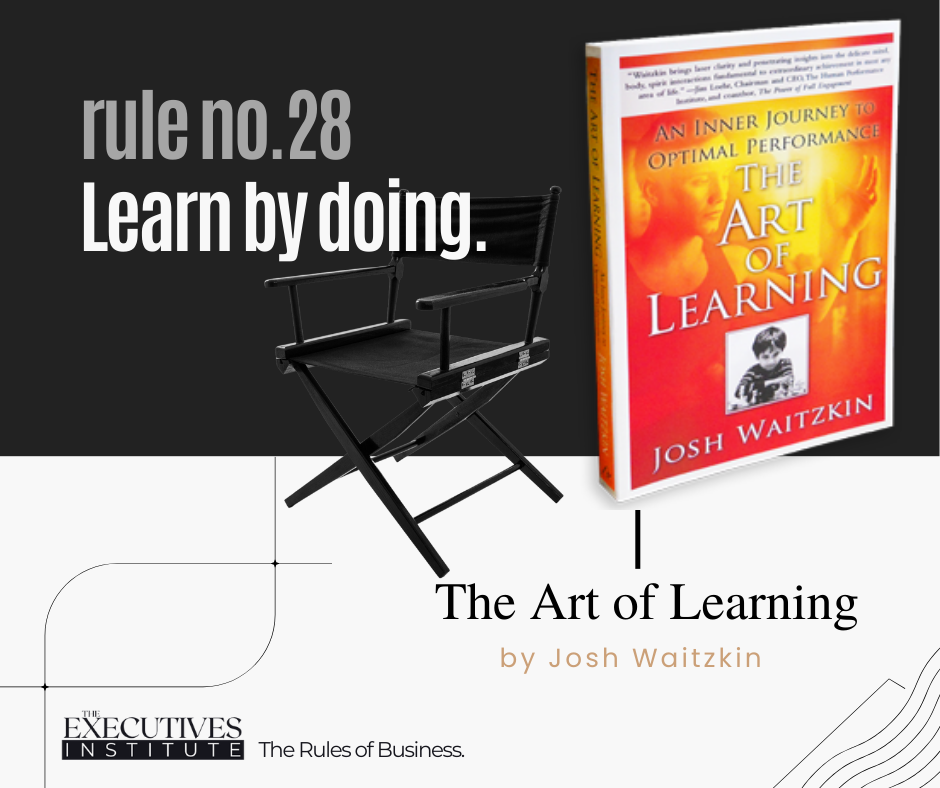
WEEK 23 RECOMMENDED READING: The Art of Learning by Josh Waitzkin
“We have to be able to do something slowly before we can have any hope of doing it correctly with speed.”
— Josh Waitzkin, The Art of Learning
Chapter 5 Complete: Ideas Don’t Build Businesses—Execution Does
You’ve made the shift. From planning to doing. From talking about priorities to making the hard calls that create progress. Many leaders get stuck here—busy but unfocused, moving but not advancing. You didn’t. You chose discipline over distraction. You built momentum. You focused on what matters. And you did the work.
Execution isn’t glamorous—but it’s what separates the wishful from the impactful.
Now, it’s time to confront what execution often uncovers: the uncomfortable truths.
Next Up: Chapter 6 — Hard Conversations, Hard Decisions
Leadership means saying the thing no one else will—and acting on it.
Some problems can’t be solved with strategy or hustle. They require guts. You’ll face the dead weight that needs cut, the decisions you’ve been delaying, and the conversations that could change everything—if you’re willing to have them.
Avoidance stalls growth. Candor sets it free. Let’s go there. VISIT CHAPTER 6
